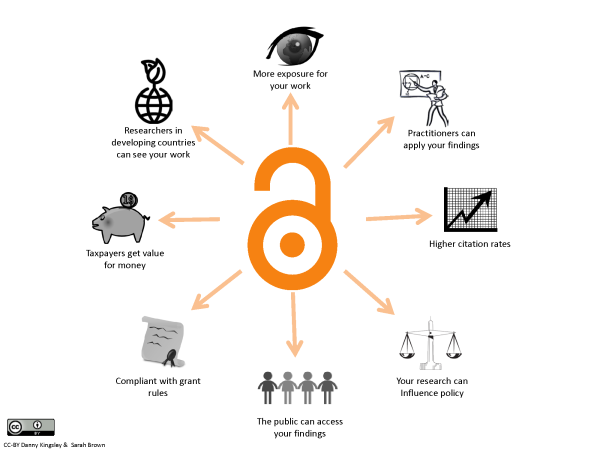What is Open Science
الخطوط العريضة للقسم
-
A good way to start thinking about this is to look at the various components shown in the picture in the introduction above. Here is another:

From Danny Kingsley & Sarah Brown licensed under the Creative Commons Attribution 4.0 International license.
UNESCO has defined Open Science as “an inclusive construct that combines various movements and practices aiming to make scientific knowledge openly available, accessible and reusable for everyone…”. In 2015, 45% of the scholarly literature was found to be available for free access, and free access articles had an 18% citation advantage suggesting that they reach a wider audience than those behind a paywall.
A blog from Open Scholar gives a nice summary:
Open Science: Purpose, Benefits, and What it Means for You
Although it’s not a new term, “open science” is quickly becoming more widely and frequently used in all types of academic settings. But what exactly is open science, and why does it matter?
What is Open Science?
To begin, open science is the movement to enable research, and its dissemination, to be accessible by all members of society, free of cost. This includes publications, data, and software. Research is often a collaborative effort. Due to this, the support for open science derives from the idea that all of society should benefit from its findings. Open science is a broader term that encompasses the following:
- Open research data
- Open scientific publications
- Open access
- Open peer review
- Open collaboration
A particular problem for the Global South
Due to a relative scarcity of research capacity, much of the Global South lacks locally relevant and globally valid research on its populations. Research publications from the Global South are low relative to the Global North. Despite a 51% increase between 2008 and 2014, in 2014 sub-Saharan Africa produced only 1.4% of the world’s share of scientific publications. Research outputs from Africa have mainly been limited to 10 countries, with more than 90% of total publications in Africa from these countries.
Reasons for this poor research output may include lack of access to scientific literature, and open publishing provides one way to improve the situation.
In a study of 174 journals from 13 African countries reporting on public health research, the majority of articles were freely available to download. However, only a minority were indexed so could be easily found by other researchers or policy makers. These findings (to be published) stimulated the development of this resource for journal editors and researchers.
-
Look at this nice graphic which demonstrates a number of reasons to encourage Open Science
-
A very nice discussion of how Covid-19 has changed everything!
-
Very nice historical account of the development of open publishing
-
-
A good review of the benefits of open publishing to 2016. Published in F1000 Research, itself an innovative open publishing journal.
